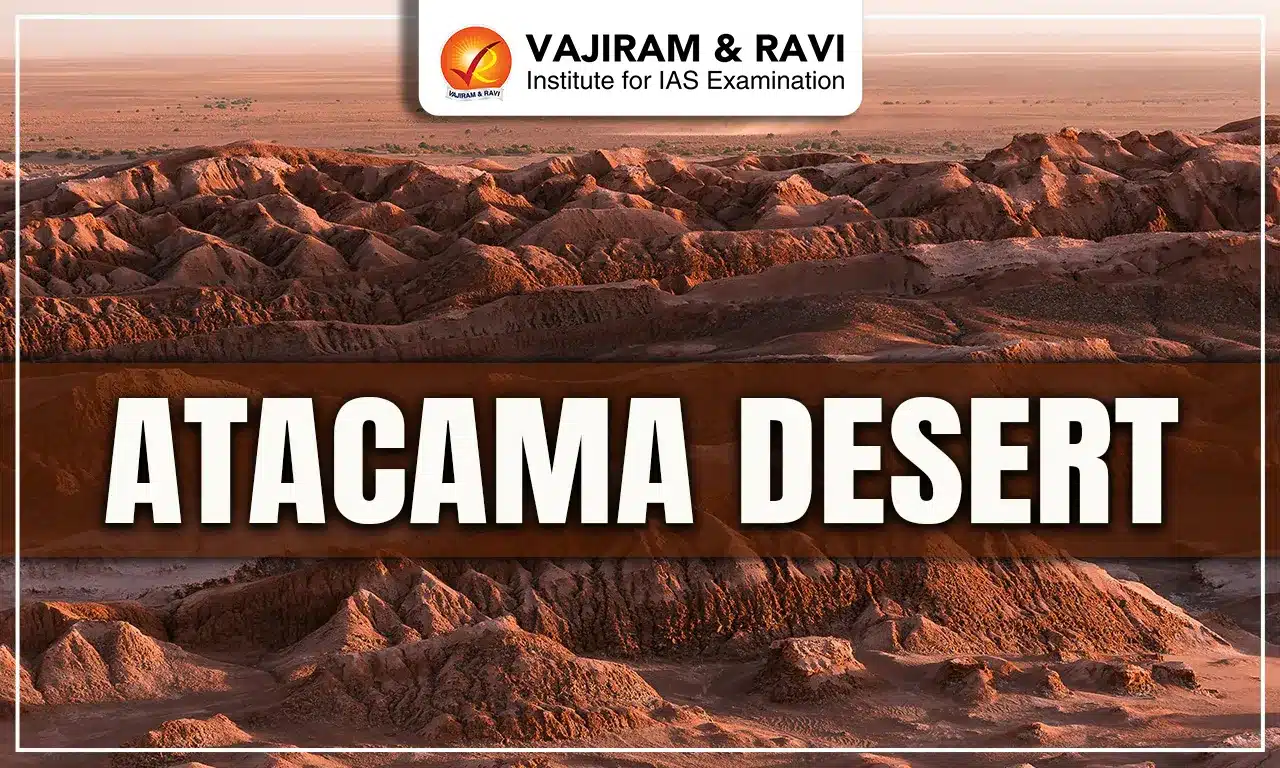Atacama Desert Latest News
Scientists are studying a small, resilient flower Cistanthe longiscapa in Chile’s arid Atacama that could hold genetic clues to help crops withstand worsening drought conditions driven by climate change.
About Atacama Desert
- Location: It is the driest desert in the world, located in northern Chile.
- It is nestled between the Andes Mountains on the east and the Pacific Ocean on the west.
- It forms a continuous strip for nearly 1,000 km along the narrow coast of the northern third of Chile.
- Bordered by: It is bordered by Argentina, Peru, and Bolivia
- It also hosts 12 volcanoes, mainly located in the western outliers of the Andes.
- Rainfall: Average rainfall in this region is about 1 mm per year. Some locations within the desert have never had any rainfall whatsoever.
- Temperature: Temperatures are comparatively mild throughout the year. The average temperature in the desert is about 63 degrees F (18 degrees C).
- Natural Resources: This region has the largest natural supply of Sodium Nitrate, which can be used for producing fertilizers and explosives, amongst other things.
- Chinchorro Mummies: The oldest artificially mummified human remains have been found in the Atacama Desert.
What is Cistanthe longiscapa?
- It is a small, resilient flower known locally as “pata de guanaco,” blooms during rare rainfall events in the Atacama desert.
- It has the ability to switch between different types of photosynthesis, making it a model plant for extreme environments.
- Under stress from drought, intense sunlight or salinity, the plant activates a water-saving method known as Crassulacean Acid Metabolism (CAM) metabolism.
- When conditions improve, it reverts to the more common C3 photosynthesis.
Source: DD News
Last updated on December, 2025
→ Check out the latest UPSC Syllabus 2026 here.
→ Join Vajiram & Ravi’s Interview Guidance Programme for expert help to crack your final UPSC stage.
→ UPSC Mains Result 2025 is now out.
→ UPSC Notification 2026 is scheduled to be released on January 14, 2026.
→ UPSC Calendar 2026 is released on 15th May, 2025.
→ The UPSC Vacancy 2025 were released 1129, out of which 979 were for UPSC CSE and remaining 150 are for UPSC IFoS.
→ UPSC Prelims 2026 will be conducted on 24th May, 2026 & UPSC Mains 2026 will be conducted on 21st August 2026.
→ The UPSC Selection Process is of 3 stages-Prelims, Mains and Interview.
→ UPSC Result 2024 is released with latest UPSC Marksheet 2024. Check Now!
→ UPSC Prelims Result 2025 is out now for the CSE held on 25 May 2025.
→ UPSC Toppers List 2024 is released now. Shakti Dubey is UPSC AIR 1 2024 Topper.
→ UPSC Prelims Question Paper 2025 and Unofficial Prelims Answer Key 2025 are available now.
→ UPSC Mains Question Paper 2025 is out for Essay, GS 1, 2, 3 & GS 4.
→ UPSC Mains Indian Language Question Paper 2025 is now out.
→ UPSC Mains Optional Question Paper 2025 is now out.
→ Also check Best IAS Coaching in Delhi
Atacama Desert FAQs
Q1. Why is the Atacama Desert considered unique?+
Q2. What is notable about the soil in the Atacama Desert?+
Tags: atacama desert

















